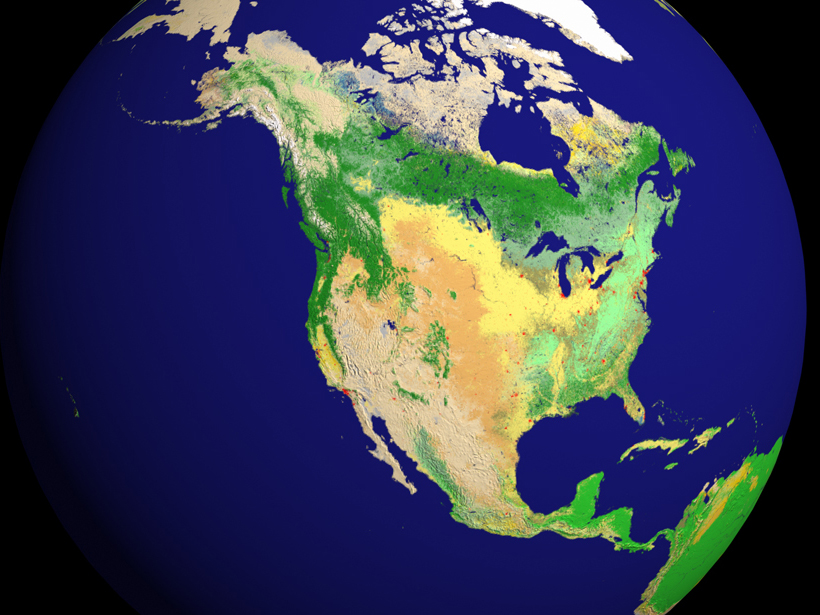The fifth biennial meeting of the North American Carbon Program (NACP) Principal Investigators (PIM5) convened in January in Washington, D. C., to review the current state of terrestrial, oceanic, and atmospheric carbon cycle research across North America. The meeting comprised 77 plenary talks and 254 posters, and it brought together 362 scientists from the United States, Canada, and Mexico.
Since its establishment in 2005, the NACP has promoted integrated research on the impact of multiple greenhouse gases on carbon and other global biogeochemical cycles. The NACP community also seeks better interaction among scientists, economists, and policy makers to strengthen the incorporation of up-to-date carbon cycle science into decision-making processes.
At the 2015 meeting, keynote speakers called for improved linkages between research on biophysical controls of the carbon cycle and socioeconomic and policy implications for carbon cycle and climate change research. To achieve this, participants agreed that the community needs a better understanding of the format and delivery mechanisms of data (including uncertainty) to inform policy and ecosystem management.
Speakers from the White House, the British Columbia Ministry of the Environment, Natural Resources Canada, the National Oceanic and Atmospheric Administration, the American Association for the Advancement of Science, and other governmental and nongovernmental bodies offered their visions of pathways toward more policy-relevant research.
Breakout sessions presented many opportunities for collaboration. The sessions revealed the NACP community’s interest in linking observations and modeling (such as in improving land carbon measurement and projections) to address the 2013 White House Climate Action Plan and to secure international emissions reduction commitments.
Better communication of NACP research is needed to reach different audiences and all stakeholders in the carbon cycle science community.
Participants also agreed that better communication of NACP research is needed to reach different audiences and all stakeholders in the carbon cycle science community. Hollywood and YouTube science communication experts Randy Olson and Derek Muller provided videographic evidence and guidelines for effective communication techniques for NACP research.
Throughout the meeting, speakers offered insights into carbon cycle data needs and opportunities for informing policy formulation and decision making domestically and internationally. Finally, participants discussed the necessity for researchers and organizations that compare energy use across geopolitical boundaries to implement effective standardization of units and measurement scales.
The meeting represented a step forward for the collaboration between the ocean and land margin carbon cycle science communities.
The meeting represented a step forward for the collaboration between the ocean and land margin carbon cycle science communities, highlighting the notion of a “boundless” carbon cycle with land margin ecosystems providing a critical link in the lateral transport from land to ocean. For example, “blue carbon” (the carbon stored in mangroves, salt marshes, and sea grasses) ecosystems contain significant carbon stocks and sequestration potential, but they are experiencing severe degradation from rising urbanization and other global change drivers. To address such coastal research needs, aspects of a draft Coastal Carbon Science Plan stemming from NACP synthesis efforts, which will be released soon, were discussed.
The meeting underscored the ongoing need for further integration across land, ocean, and atmosphere to improve process-based knowledge and support socioeconomic and policy-relevant applications. New technologies, research and monitoring networks, and theoretical approaches to understanding the dynamics of multiple greenhouse gases will facilitate applicability and transferability of North American carbon cycle science in decision making within and across jurisdictional and geopolitical boundaries. Fully realizing the potential of these new capabilities requires improving, maintaining, and enhancing coordination and communication among researchers, funding entities, observational networks, and data management and interoperability platforms across North America and the world.
Peter Griffith (NACP emeritus coordinator) contributed to this article. The PIM5 Organizing Committee and NACP Office organized the meeting with funding from the Carbon Cycle Interagency Working Group (via the U.S. Carbon Cycle Science Program Office), NASA, and the U.S. Department of Energy.
—Rodrigo Vargas, University of Delaware, Newark; email: [email protected]; Simone Alin, NOAA Pacific Marine Environmental Laboratory, Seattle, Wash.; and Gyami Shrestha, U.S. Carbon Cycle Science Program/Carbon Cycle Interagency Working Group, U.S. Global Change Research Program, Washington, D. C.
Citation: Vargas, R., S. Alin, and G. Shrestha (2015), Integrating carbon cycle research into decision-making processes, Eos, 96, doi:10.1029/2015EO037893. Published on 26 October 2015.
Text © 2015. The authors. CC BY-NC 3.0
Except where otherwise noted, images are subject to copyright. Any reuse without express permission from the copyright owner is prohibited.

